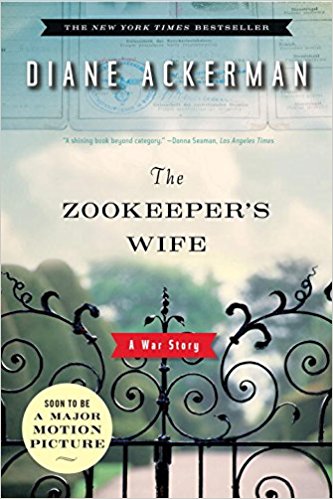The Zookeeper’s Wife Summary
7 min read ⌚
 Our “The Zookeeper’s Wife PDF Summary” takes you back to a time when humans were animals and animals – humans; but, it’s not a prehistoric age: it’s the Warsaw Zoo between 1939 and 1945.
Our “The Zookeeper’s Wife PDF Summary” takes you back to a time when humans were animals and animals – humans; but, it’s not a prehistoric age: it’s the Warsaw Zoo between 1939 and 1945.
A War Story
The better angels of our nature sometimes work as zookeepers. And they risk their lives on a daily basis.
Join us in reading “The Zookeeper’s Wife,” Diane Ackerman’s fascinating account of a wedded Polish couple who saved hundreds of Jews during the Holocaust in Warsaw.
Who Should Read “The Zookeeper’s Wife”? And Why?
If you like to read uplifting stories about the Holocaust, “The Zookeeper’s Wife” may just become one of your all-time favorites. The same holds true if you are merely interested in finding out more about that gruesome event from a never-before thought-of perspective.
And if you like to read nonfiction books which sound more made-up than novels – this book’s for you as well.
About Diane Ackerman
 Diana Ackerman is an American poet and essayist, most famous for her love of nature and her interest to explore it in a poetic manner.
Diana Ackerman is an American poet and essayist, most famous for her love of nature and her interest to explore it in a poetic manner.
She has earned both an MFA and a Ph.D. in English from Cornell University. She is famous both as a poet and as a non-fiction writer.
Published in 1990, “A Natural History of the Senses” inspired a five-part PBS documentary in 1995. “The Zookeeper’s Wife” won the Orion Award in 2007 and was adapted into a Jessica Chastain movie a decade later.
“The Zookeeper’s Wife PDF Summary”
Have you ever watched “Schindler’s List”?
If so, we guess that it’s a film you’ve remembered quite vividly and would never forget.
We know we won’t!
The fact that the things happening on the movie screen have happened in real-life too gives us goosebumps every time we think about Spielberg’s masterwork. When we decide to actually see it – well, let’s just say that you don’t need tissues to take care of your goosebumps!
How is “The Zookeeper’s Wife” related to “Schindler’s List”?
Well, let’s see!
They both happen during the Second World War, somewhere in the bloodlands. Both are concerned with the fate of the Polish Jews. And both are inspiring stories about the self-sacrificing acts of few people who decided to risk their own lives in order to save those of the innocent people around them.
Unsurprisingly, both were adapted into successful Hollywood blockbusters!
“Schindler’s List” needs no introduction. So, without further ado, here’s Jessica Chastain presenting the trailer to “The Zookeeper’s Wife”:
A little warning, though: the movie – being a movie – does make few minor adjustments to the original story. So, if your teacher assigned you to write a report on “The Zookeeper’s Wife,” don’t just rely on watching the movie. They may catch you!
We don’t want to spoil anything for you, but, let’s just say that movies always tend to add a love story or two; or blow one out of proportions.
Anyway, “The Zookeeper’s Wife” recounts the story of Jan and Antonina Żabiński, the former a zoologist and director of the Warsaw Zoo, the latter an animal whisperer (we’re not kidding!) and author of few children’s books written from the perspective of – you’ve guessed it! – animals. Diane Ackerman’s book is based on Antonina’s unpublished diaries.
And it starts pretty much when the Second World War starts as well: 1939. Suddenly, Jan and Antonina’s idyllic lives as zookeepers and animal lovers come to an abrupt end.
We bet you never thought of this before, but environmentalists and ecologists sure have: during wars, animals die too! Millions and millions of them, in fact! Many are euthanized due to food shortages; others die the same way humans die: air attacks, bombings, stray bullets…
There were very few animals left in the Warsaw Zoo after September 1, 1939. At this point, the Warsaw Zoo is visited by Lutz Heck, a Nazi scientist who dreamt of breeding back some extinct animals and created two new species in the process.
He probably has “a sweet spot” for Antonina and offers the Żabińskis to take some of the surviving animals to the Berlin Zoo – for which he is responsible. You know, since, unlike Warsaw, Berlin isn’t bombed or anything!
They agree – and he takes. But, of course, mainly those animals which he needs for his experiments. Then, he invites some members of the SS and organizes them a private hunting party within the Warsaw Zoo.
We are not making this up – everything is there in Antonina’s diaries. Hiding in the room of her child, Ryszard “Ryś” Żabiński, with the blinds drawn, Antonina couldn’t stop pondering over “the sheer gratuitous slaughter.” In her diary, she posted a terrifying question: “How many humans will die like this in the coming months?”
So, she and her husband decide to do something about it.
Since Jan is an employee of the Warsaw municipality, he’s allowed to enter the Warsaw Ghetto. And, soon enough, on the pretense that or gathering garbage to feed the hogs (the Żabińskis transform the Zoo in a pig farm to keep it up and running), he starts smuggling Jews out of there.
Another thing that helps: a German officer’s obsession with bugs. Named Ziegler, he wants Jan to help him get some bugs from Dr. Szymon Tenenbaum, a bug collector in the Warsaw Ghetto. The strange thing is that Ziegler may even know that Jan sneaks people out of the ghetto.
Nevertheless, he’s willing to let it go. For the love of the bugs.
Once again: we’re not making this up!
Now, where do the Żabińskis hide these people?

The cages in the Warsaw Zoo and their villa. There, Antonina takes care of them and, when there’s a danger of them being discovered, she plays an Offenbach tune on her piano as a hiding signal.
Over 300 guests filter through the Zoo during the following years. Magdalena Gross, an artist, is one of them. She becomes a close friend with Antonina, and an even more intimate with Maurycy Pawel Fraenkel, a tortured soul who befriends a hamster named Piotr and who eventually marries Magdalena.
There’s another colorful guy, aptly called the Fox Man, because, well, he is tasked with building a fox farm on the grounds of the Zoo. Why? Well, it seems that the Nazis loved their fur.
They also loved to kill people, so it’s no surprise that as the war draws to its end, German soldiers eventually come into the Żabiński’s house and threaten Antonina. By this time, Jan has already become a prisoner of war, since he takes participation in the Warsaw Polish Uprising of the summer of 1944.
How did those soldiers end up not killing Antonina?
Well, according to her, because she controlled their actions with her mind. She believed she had the power to telepathically speak with animals. And, at this point, she thought that she went a step further.
Or backward. Because if “The Zookeeper’s Wife” teaches us anything it’s undoubtedly that sometimes humans can be as terrifying as beasts. And beasts as gentle as caring humans.
All’s well that ends well, by the way.
Antonina survives, Jan returns from the camp, and they rebuild the Zoo. And on September 21, 1965, Yad Vashem recognized Jan and Antonina as Righteous Among the Nations.
Key Lessons from “The Zookeeper’s Wife”
1. Wars Blur the Difference Between Animals and Humans
2. Music, the Great Communicator
3. Some Things Are More Important
Wars Blur the Difference Between Animals and Humans
At one point in the book, the Fox Man – whose real name, by the way, is Witold Wróblewski – expresses his amazement at the fact that in the Warsaw Zoo, they “use animal names for people and people’s names for animals!”
However, during a war, it seems quite the right thing to do! Animals didn’t kill six million Jews and cause millions of other casualties worldwide; humans did. “Why was it,” Antonina ask herself, thinking about the domesticated Zoo animals, “that animals can sometimes subdue their predatory ways in only a few months, while humans, despite centuries of refinement, can quickly grow more savage than any beast?”
We have no answer to that question. Or maybe we do – but we don’t want to think about it too much.
Music, the Great Communicator
Yes, that’s a verse from a Red Hot Chili Peppers song. And it’s a neat description of how music is capable of transcending barriers and borders. We all speak different languages. But Beethoven is Beethoven both in Germany and in Poland.
And the Żabińskis found an ingenious way to use this power. Antonina was a fine piano player, so she used music to communicate important messages to her guests. For example, whenever the guests needed to go into hiding, she would play Offenbach’s “Go to Crete!” And she used another song to note that everything’s clear.
Some Things Are More Important
It’s fascinating how wars change priorities. And even more – how sometimes even they don’t.
Case in point: the Jews are forbidden to eat pork. However, when Jan brought them such meat in the Ghetto, they had no choice but to accept it. Otherwise, they would have died.
Ziegler’s story is even more interesting. Even though all Germans were taught that the victory in the war and the extermination of the Jews is their main priority, he cared more about his bugs. How is it that the propaganda and violence raging all around him didn’t make him think differently – is beyond us!
Like this summary? We’d like to invite you to download our free 12 min app, for more amazing summaries and audiobooks.
“The Zookeeper’s Wife” Quotes
I watched her face switch among the radio stations of memory. Share on X I don't understand all the fuss. If any creature is in danger, you save it, human or animal. Share on X God may promise not to destroy creation, but it is not a promise humankind made - to our peril. Share on X Germany's crime is the greatest crime the world has ever known, because it is not on the scale of History: it is on the scale of Evolution. Share on X More broadly, the Nazis were ardent animal lovers and environmentalists who promoted calisthenics and healthy living, regular trips into the countryside, and far-reaching animal rights policies as they rose to power. Share on XOur Critical Review
“The Zookeeper’s Wife” is both a heart-wrenching and a heartwarming story. And as Jared Diamond wrote – its story is so funny, moving and terrifying, so gripping and thriller-like, that it would have made a great novel.
The only problem is – that this one’s true. And you won’t regret reading it.
Emir is the Head of Marketing at 12min. In his spare time, he loves to meditate and play soccer.







